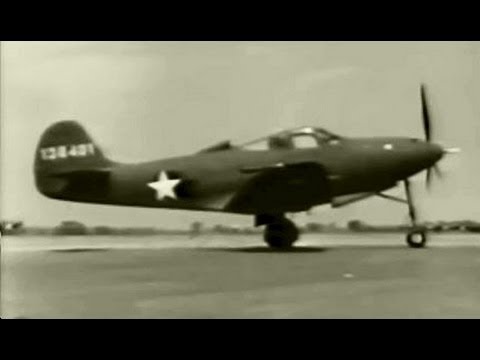more at
“Training film for military pilots of the Bell P-39 Airacobra pursuit aircraft, examining flight techniques, cockpit layout, and armament.”
NEW VERSION with improved video & sound:
Public domain film slightly cropped to remove uneven edges, with the aspect ratio corrected, and mild video noise reduction applied.
The soundtrack was also processed with volume normalization, noise reduction, clipping reduction, and/or equalization (the resulting sound, though not perfect, is far less noisy than the original).
also see: “Flying the P-39”
PILOT TRAINING PLAYLIST:
The Bell P-39 Airacobra was one of the principal American fighter aircraft in service when the United States entered World War II. Designed by Bell Aircraft, it had an innovative layout, with the engine installed in the center fuselage, behind the pilot, and driving a tractor propeller via a long shaft. It was also the first fighter fitted with a tricycle undercarriage. Although its mid-engine placement was innovative, the P-39 design was handicapped by the absence of an efficient turbo-supercharger, limiting it to low-altitude work. The P-39 was used with great success by the Soviet Air Force, which scored the highest number of individual kills attributed to any U.S. fighter type… Together with the derivative P-63 Kingcobra, these aircraft became the most successful mass-produced fixed-wing aircraft manufactured by Bell…
The XP-39 made its maiden flight on 6 April 1939. at Wright Field, Ohio, achieving 390 mph (630 km/h) at 20,000 ft (6,100 m), reaching this altitude in only five minutes. However, the XP-39 was found to be short on performance at altitude. Flight testing had found its top speed at 20,000 feet to be lower than the 400 mph claimed in the original proposal…
The production P-39 retained a single-stage, single-speed supercharger with a critical altitude (above which performance declined) of about 12,000 feet (3,660 m) (3,658 m). As a result, the aircraft was simpler to produce and maintain. However, the deletion of the turbo destroyed any chance that the P-39 could serve as a medium-high altitude front-line fighter…
The P-39 was an all-metal, low-wing, single-engine fighter, with a tricycle undercarriage and an Allison V-1710 liquid-cooled V-12 engine mounted in the central fuselage, directly behind the cockpit.
The Airacobra was one of the first production fighters to be conceived as a “weapons system”; in this case the aircraft (known originally as the Bell Model 4) was designed around the 37mm T9 cannon. This weapon, which was designed in 1934 by the American Armament Corporation, a division of Oldsmobile, fired a 1.3 lb (610 g) projectile capable of piercing .8 in (2 cm) of armor at 500 yd (450 m) with armor-piercing rounds. The 200 lb, 90 inch long weapon had to be rigidly mounted and fire parallel to and close to the centerline of the new fighter… Weight, balance and visibility problems meant that the cockpit could not be placed farther back in the fuselage, behind the engine and cannon. The solution adopted was to mount the cannon in the forward fuselage and the engine in the center fuselage, directly behind the pilot’s seat. The tractor propeller was driven via a 10-foot-long (3.0 m) drive shaft which was made in two sections, incorporating a self-aligning bearing to accommodate fuselage deflection during violent maneuvers. This shaft ran through a tunnel in the cockpit floor and was connected to a gearbox in the nose…
The RAF eventually ordered a total of 675 P-39s. However, after the first Airacobras arrived at 601 Squadron RAF in September 1941, they were promptly recognized as having an inadequate rate of climb and performance at altitude for Western European conditions. Only 80 were adopted, all of them with 601 Squadron. Britain transferred about 200 P-39s to the Soviet Union.
Another 200 examples intended for the RAF were taken up by the USAAF after the attack on Pearl Harbor as the P-400, and were sent to the Fifth Air Force in Australia, for service in the South West Pacific Theatre.
By the time of the Pearl Harbor attack, nearly 600 P-39s had been built. When P-39 production ended in August 1944, Bell had built 9,558 Airacobras, of which 4,773 (mostly −39N and −39Q) were sent to the Soviet Union through the Lend-Lease program. There were numerous minor variations in engine, propeller, and armament, but no major structural changes in production types, excepting a few two-seat TP-39F and RP-39Q trainers…
Trials of a laminar flow wing (in the XP-39E) and Continental IV-1430 engine (the P-76) were unsuccessful. The mid-engine, gun-through-hub concept was developed further in the Bell P-63 Kingcobra…

